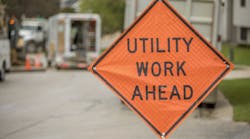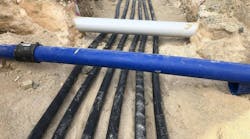Power delivery resiliency can be accomplished by electric utilities in different ways, but most efforts are focused on either a plan to harden the overhead system or place facilities underground. In respect to undergrounding, electric utilities understand that it is often not feasible from a cost and routing perspective to underground all facilities.
However, a potential cost-effective approach is for select lines to be placed underground based on specific design requirements and perceived societal benefits. It is difficult to assess the societal benefit for undergrounding in every specific situation beforehand, but by using a strategic approach with data-driven results, utilities can plan and better optimize the resiliency of their distribution systems.
The T&D World webinar sponsored by Dow on Dec. 5 provided analysis results from two energy research experts that examined undergrounding resiliency effectiveness for certain utilities and specific states. Historical data, statistical modeling and quantified results were presented by Dr. Richard Brown (Exponent Inc.) and Dr. Peter Larsen (Lawrence Berkeley National Laboratory).
Targeted Approach and Impact
Brown presented a case study on the Societal Benefit of Undergrounding. He cited from a previous study that the benefit-to-cost result of undergrounding three-phase “trunk lines” or entire feeders is cost-prohibitive, indicating that burying these lines would raise electric rates by three to four times current levels. However, he explained that in his work supporting Dominion Virginia Power’s (DVP) Strategic Underground Program, he was able to perform a detailed analysis on the impact that undergrounding targeted tap lines would yield in societal benefit.
To begin, it was established that the average cost to underground DVP tap lines was $350,000 per mile. He subsequently used 19 years of DVP historical data to build a Storm Model that characterized different event severities, determined the likely frequency of these events, and then correlated the percentage of customers’ outages by event duration.
The previous results were then used to build a Major Weather Event Restoration Model, which led to a Storm Restoration Reduction Model that provided key results. The most telltale result of that model was the Crew-Hour Reduction for each storm scenario.
His next step to complete the benefit-to-cost assessment was to use the gross domestic product (GDP) for Virginia and proportion it to electric usage. This resulted in a GDP DVP outage cost of $35,458 per hour.
Subsequently, the Crew-Hour Reduction was modeled with the GDP impact to produce an expected GDP saved ($/yr) for each storm scenario. The outcome was a total annualized GDP loss avoidance benefit that resulted in a 1.76 benefit-to-cost ratio. This benefit-to-cost ratio confirmed that DVP’s Strategic Underground Program targeting tap lines would be cost-effective and justified.
Ultimately, DVP’s ability to reduce the total system restoration time by avoiding crew-hours normally spent on overhead tap lines allows them to more quickly respond to higher density, higher impact areas. This strategic focus and impact is a win-win for their customers.
Assessing Costs and Benefits for Resiliency
Despite the high costs attributed to power outages, there is a lack of established cost-benefit research that can be used by utilities to improve power system resilience. Typically, industry “underground vs. overhead” cost information shows premium cost multipliers for undergrounding up to an order-of-magnitude or higher. So, utilities need accurate, researched cost-benefit data to seriously consider a strategic undergrounding program.
Larsen recognized the need for additional industry research and decided to expand upon previous research conducted by Brown for the state of Texas. This led Larsen to develop an analysis framework that considered the cost impact of replacing all end-of-life overhead facilities with underground. This included selected costs such as worker accidents, higher installation costs, permitting and ecosystem right-of-way. The selected benefits expected were lower operations and maintenance, decreased frequency of outages and avoided aesthetic costs.
The conclusion of Larsen’s analysis in Texas indicated a net social loss (i.e., costs exceeded the benefits) to implement an end-of-life undergrounding mandate for regulated, investor-owned utilities across Texas. The analysis varied all key assumptions and still yielded consistent net social losses. The sensitivity analysis determined that the three most influential factors were discount rate, undergrounding replacement cost and overhead line lifespan.
Based on the results of Larsen’s analysis, he believes that undergrounding lines could lead to net social benefits in places where:
- There is a large number of customers per mile.
- There is an expected vulnerability to frequent and intense storms.
- There is potential for underground line installation economies-of-scale.
- Overhead line utility easements are larger than underground line easements.
A second case study was presented by Larsen, which involved a cooperative utility in Cordova, Alaska. The utility had completed a 30-year plus undergrounding program and Larsen performed an ex-post facto analysis.
The Cordova study caused him to reconfigure the Texas model to accommodate the unique conditions of a smaller, isolated electric utility. The selected benefits were lower operations and maintenance, decreased frequency of outages, decreased ecosystem right-of-way, avoided aesthetic costs, and decreased worker accidents. In this case, even though the same generally methodology was used, the results were dramatically different.
The net social benefit of this application produced a 16 to 1 benefit-to-cost ratio (i.e., for every dollar invested in undergrounding, there were $16 in societal benefits to the community of Cordova). The sensitivity analysis showed that the value of lost load, reliability impact, and overhead distribution lifespan were the most influential factors. In addition, a positive net benefit resulted even when all key parameters were varied simultaneously to minimum and maximum values.
In conclusion, Brown and Larsen have provided evidence that system resiliency improvements can be achieved with a targeted undergrounding program. The strategy employed should quantify historical data and consider all relevant costs and factors to produce a net societal benefit. If the undergrounding costs and benefits are considered in a prudent reasonable manner, an accurate assessment can be performed to determine the proper approach for undergrounding at your utility.
Building the Plan: Strategic and data-driven grid resiliency programs is now available on-demand. This was the third webinar in a three-part series sponsored by Dow addressing challenges facing the industry.
The ICE Calculator is a tool that was developed by Lawrence Berkeley National Laboratory for the Department of Energy to estimate customer interruption costs for specific service territories based on data supplied from 34 utilities: https://icecalculator.com/home.


